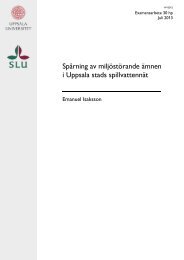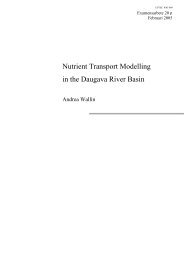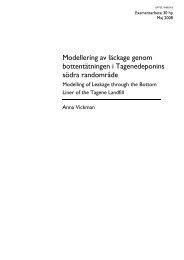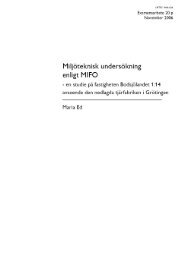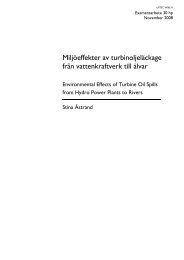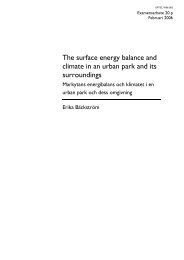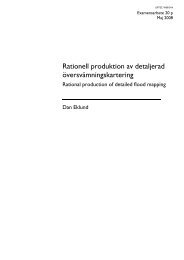Substansflödesanalys av tungmetaller i avloppssystemet - DiVA
Substansflödesanalys av tungmetaller i avloppssystemet - DiVA
Substansflödesanalys av tungmetaller i avloppssystemet - DiVA
You also want an ePaper? Increase the reach of your titles
YUMPU automatically turns print PDFs into web optimized ePapers that Google loves.
ABSTRACTSubstance flow analysis of he<strong>av</strong>y metals in the sewage system– New tool tested for the two municipalities Sigtuna and SolnaSara Agduhr EronenThe urban he<strong>av</strong>y metal flow can contribute to resource problems due to the reuse ofsewage sludge on arable land. The purpose of this master thesis was to provide KäppalaAssociation with a tool that can be used to identify sources of he<strong>av</strong>y metals to theirincoming sewage water and thus support their ongoing work to improve the waterquality. The objective was to perform substance flow analysis for five metals cadmium,copper, chromium, mercury and zinc, for the central Swedish municipalities Sigtunaand Solna which are a part of the Käppala catchment area. The tool developed should beable to identify the sources of he<strong>av</strong>y metals, the amount of emissions and also be able toprovide information about where measures are most effective.In order to develop the tool the system was defined into five domains, households,business, storm water, leakage water and other. He<strong>av</strong>y metal sources were identifiedand grouped into one of the five domains. Emission coefficients (sources) and formulaswere compiled for quantification of the flows of he<strong>av</strong>y metals. In order to test the tooland get a source distribution for the five studied metals, a case study was carried out foreach of the municipalities. Estimation of the uncertainties of the tool and thereasonableness of the results were made in a validation and a sensitivity analysis.The work resulted in the tool SoFi, which was developed in Microsoft Office Excel andwhich calculates the quantities and source distribution of he<strong>av</strong>y metals brought to thesewage system. SoFi also estimates areas where measures are most efficient. The casestudies showed that the households are the greatest source of he<strong>av</strong>y metals to thesewage system. The validation generally showed that the calculated amounts from SoFicoincided well with estimations of the amounts from the two case studies, but that therewas an underestimation of the amount of zinc. The sensitivity analysis showed that SoFiis sensitive to uncertainties in the emission coefficients.Possible measures directed towards the households are information campaigns aimed atraising the awareness of which products that contain and emit he<strong>av</strong>y metals to thesewage system. An interesting further development of SoFi is an extension of thehousehold domain to identify which of these products that contributes the most.Key words: Substance flow analysis, he<strong>av</strong>y metals, emission coefficient, sourcedistribution, SoFiDepartment of Earth Sciences, Air, Water and Landscape Sciences, Uppsala University,Earth Science Centre , Vill<strong>av</strong>ägen 16, SE-752 36 Uppsala, SwedenISSN 1401-5765II








